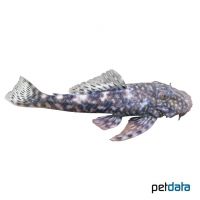Bola Pleco (Peckoltichthys bachi)
| Bola Pleco Peckoltichthys bachi | |
|---|---|
| Name | Bola Pleco |
| Name Lat. | Peckoltichthys bachi |
| Synonym | Peckoltia bachi, L146, L232, LDA30 |
| Family | Suckermouth Armoured Catfishes |
| Family lat. | Loricariidae |
| Order | Catfishes |
| Order lat. | Siluriformes |
| Origin | NW-South America |
| Habitat | Rivers, streams |
| Diet | Omnivore, soft wood |
| pH | 6.0-7.5 |
| Behavior | Nocturnal, peaceful |
| Keeping | Individual, group |
| Care Level | Moderate |
| Reproduction | Cave spawner |
| Breeding | Difficult |
| Life Span | N/A |
| Protection | No |
| Metric Units | |
| Size | 13 cm |
| Temperature | 25-29 °C |
| Hardness | < 15 °dH |
| Aquarium | ~ 200 l |
| US Units | |
| Size | 5" |
| Temperature | 77-84 °F |
| Hardness | < 267 ppm |
| Aquarium | ~ 50 gal |
Distribution and habitat
Ucayali flathead catfish are widely distributed in Peru, Colombia, Ecuador Brazil. They live in the shore area of calm to moderately flowing rivers with roots, sunken logs and branches protruding into the water.
Maintenance
The aquarium should have a robust planting, with stones and caves (catfish burrows) and roots that provide hiding places and at the same time are part of their diet. A sandy substrate, some subdued light (floating plants) and a weak to moderate current is ideal.
No ammonia, ammonium and nitrite should be detectable, the nitrate value should not exceed 100 mg/l. To ensure the water quality and oxygen content, a filter and heater adapted to the aquarium size is required, as well as lighting for the species-appropriate day-night rhythm of the animals.
Diet
They feed on plant and animal food. For a balanced diet, feed once a day with a high-quality dry food for loricariid catfish (granules, pellets, chips, tablets), supplemented with algae leaves, soft wood and fresh vegetables, such as zucchini, broccoli, bruised peas, scalded spinach, as well as zoopankton, cyclops, daphnia, artemia, mosquito larvae, etc. (live or frozen)
Feed only as much as will be eaten within a few minutes, excluding plant foods. Regular and varied feeding promotes health and increases resistance.
Behaviour and compatibility
They are crepuscular to nocturnal. Within the species they behave occasionally territorial, so several animals should be maintained only in a richly structured tank. They are very peaceful towards other fish and are well suited for a community tank
Basically, only compatible fish species with similar demands on water quality and water temperature may be socialized.
Sex dimorphism
Sexually mature males have odontodes (pointed skin teeth) on the hind body.
Reproduction and breeding
There are isolated reports of successful breeding in the aquarium. They spawn in caves. The clutch consists of up to 150 eggs and is cared for by the male. The fry hatch after 4-7 days and swim freely after about 2 weeks.
The fry must be fed several times a day with special rearing food. In community tanks breeding is hardly possible, because the fry are easy prey here.
Important
When trapping, use the finest mesh nets possible to avoid snagging the hard rays of the pectoral fins or the skin teeth (odontodes) located on the bone plates, which can cause painful puncture wounds when touched.
The well-being of the fish should be checked regularly. Temperature should be checked daily, pH, hardness and nitrate levels at least every 14 days. Regular partial water changes are recommended, even when contaminant levels have not yet reached the upper limit. Sudden changes in water quality should be avoided. Newly introduced fish must be accustomed slowly to the water in the aquarium.
Further literature can be found in your pet store.
References
Text: Werner Winter; Image: petdata
Source: BMELV (1998): Tierschutzgutachten - Haltung von Zierfischen (Süßwasser); ENGELMANN (2005): Zootierhaltung - Tiere in menschlicher Obhut: Fische, Verlag Harri Deutsch; WERNER, LECHNER, SCHMIDT (2005): MiniAtlas L-Welse, Bede Verlag; SEIDEL, EVERS (2005): Wels Atlas Band 2, Mergus Verlag
- Gemäß § 21 Abs. 5 Tierschutzgesetz idgF
